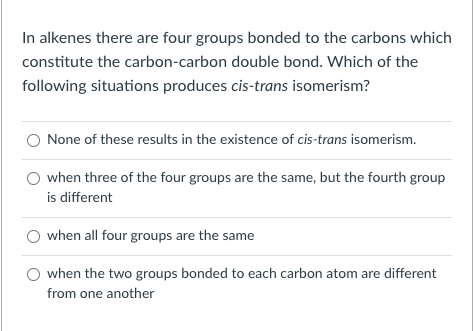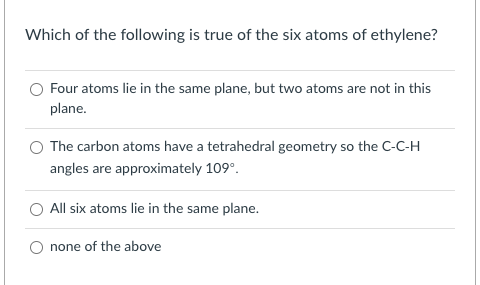In alkenes there are four groups bonded to the carbons which constitute the carbon-carbon double bond. Which of the following situations produces cis-trans isomerism? O None of these results in the existence of cis-trans isomerism. when three of the four groups are the same, but the fourth group is different O when all four groups are the same O when the two groups bonded to each carbon atom are different from one another
In alkenes there are four groups bonded to the carbons which constitute the carbon-carbon double bond. Which of the following situations produces cis-trans isomerism? O None of these results in the existence of cis-trans isomerism. when three of the four groups are the same, but the fourth group is different O when all four groups are the same O when the two groups bonded to each carbon atom are different from one another
Introductory Chemistry: An Active Learning Approach
6th Edition
ISBN:9781305079250
Author:Mark S. Cracolice, Ed Peters
Publisher:Mark S. Cracolice, Ed Peters
Chapter13: Structure And Shape
Section: Chapter Questions
Problem 78E
Related questions
Question

Transcribed Image Text:In alkenes there are four groups bonded to the carbons which
constitute the carbon-carbon double bond. Which of the
following situations produces cis-trans isomerism?
None of these results in the existence of cis-trans isomerism.
when three of the four groups are the same, but the fourth group
is different
O when all four groups are the same
when the two groups bonded to each carbon atom are different
from one another

Transcribed Image Text:Which of the following is true of the six atoms of ethylene?
Four atoms lie in the same plane, but two atoms are not in this
plane.
The carbon atoms have a tetrahedral geometry so the C-C-H
angles are approximately 109°.
All six atoms lie in the same plane.
none of the above
Expert Solution
This question has been solved!
Explore an expertly crafted, step-by-step solution for a thorough understanding of key concepts.
This is a popular solution!
Trending now
This is a popular solution!
Step by step
Solved in 2 steps

Knowledge Booster
Learn more about
Need a deep-dive on the concept behind this application? Look no further. Learn more about this topic, chemistry and related others by exploring similar questions and additional content below.Recommended textbooks for you

Introductory Chemistry: An Active Learning Approa…
Chemistry
ISBN:
9781305079250
Author:
Mark S. Cracolice, Ed Peters
Publisher:
Cengage Learning

Chemistry: Principles and Practice
Chemistry
ISBN:
9780534420123
Author:
Daniel L. Reger, Scott R. Goode, David W. Ball, Edward Mercer
Publisher:
Cengage Learning

Organic And Biological Chemistry
Chemistry
ISBN:
9781305081079
Author:
STOKER, H. Stephen (howard Stephen)
Publisher:
Cengage Learning,

Introductory Chemistry: An Active Learning Approa…
Chemistry
ISBN:
9781305079250
Author:
Mark S. Cracolice, Ed Peters
Publisher:
Cengage Learning

Chemistry: Principles and Practice
Chemistry
ISBN:
9780534420123
Author:
Daniel L. Reger, Scott R. Goode, David W. Ball, Edward Mercer
Publisher:
Cengage Learning

Organic And Biological Chemistry
Chemistry
ISBN:
9781305081079
Author:
STOKER, H. Stephen (howard Stephen)
Publisher:
Cengage Learning,

General, Organic, and Biological Chemistry
Chemistry
ISBN:
9781285853918
Author:
H. Stephen Stoker
Publisher:
Cengage Learning

Chemistry: The Molecular Science
Chemistry
ISBN:
9781285199047
Author:
John W. Moore, Conrad L. Stanitski
Publisher:
Cengage Learning

Chemistry & Chemical Reactivity
Chemistry
ISBN:
9781337399074
Author:
John C. Kotz, Paul M. Treichel, John Townsend, David Treichel
Publisher:
Cengage Learning